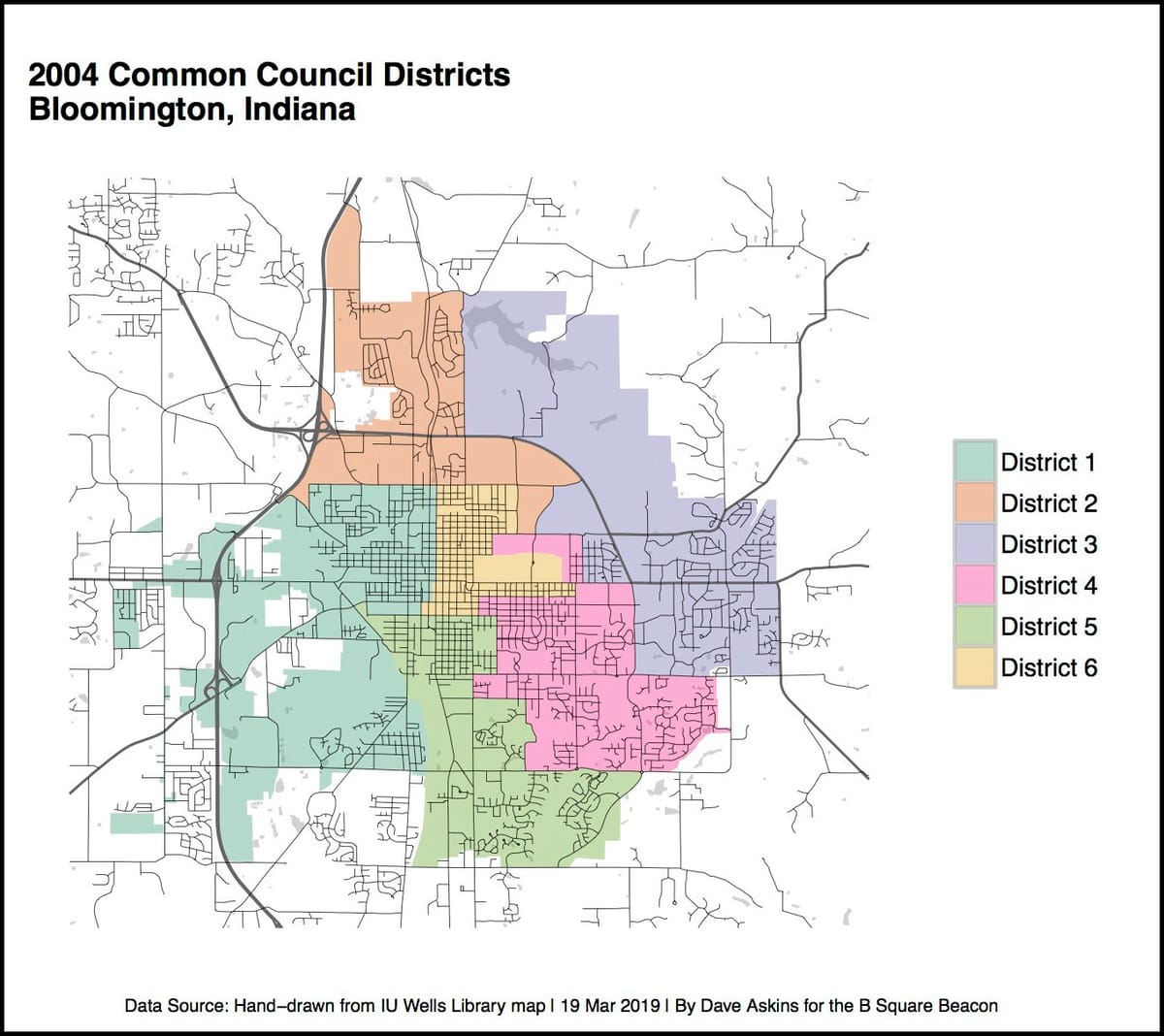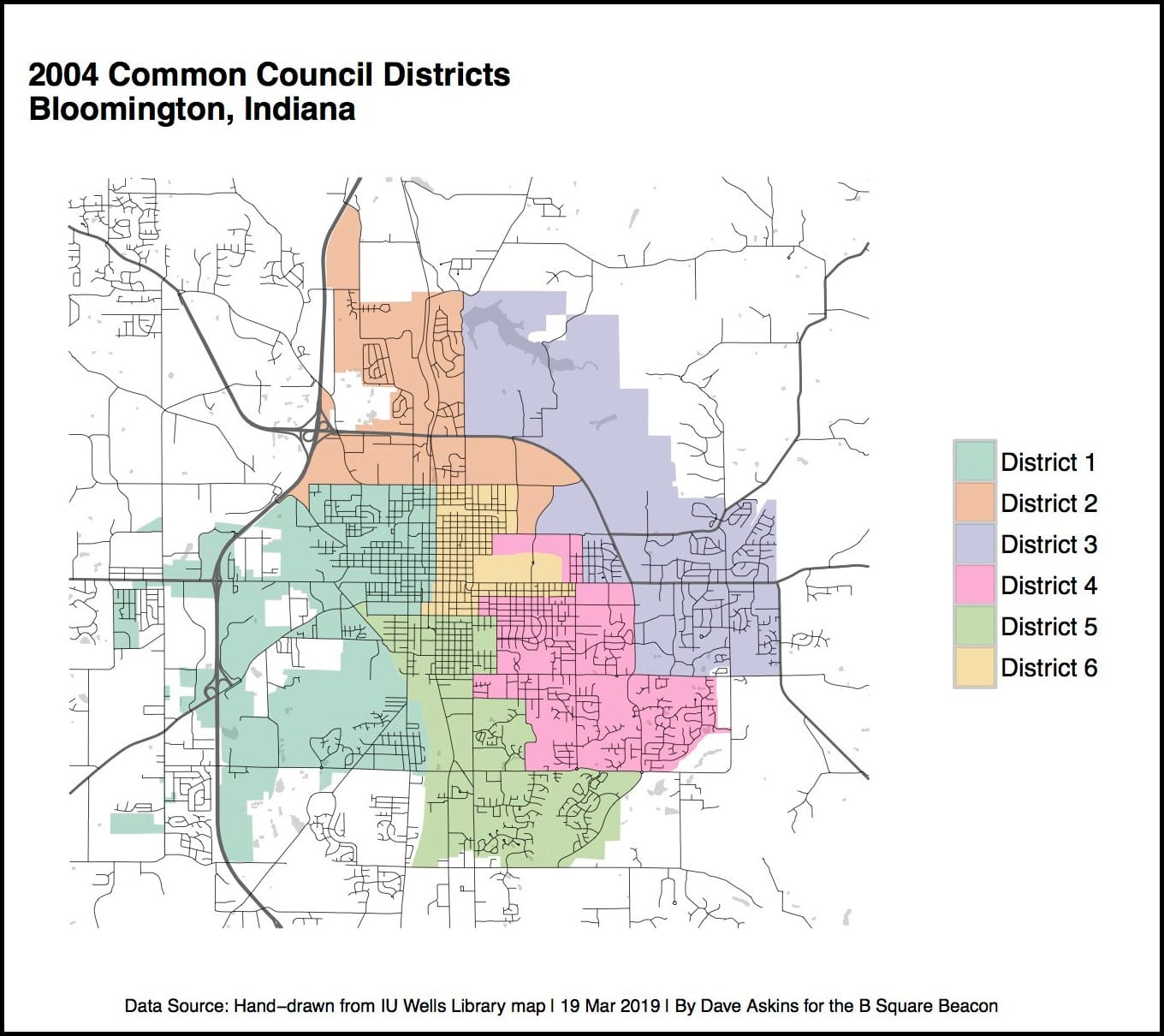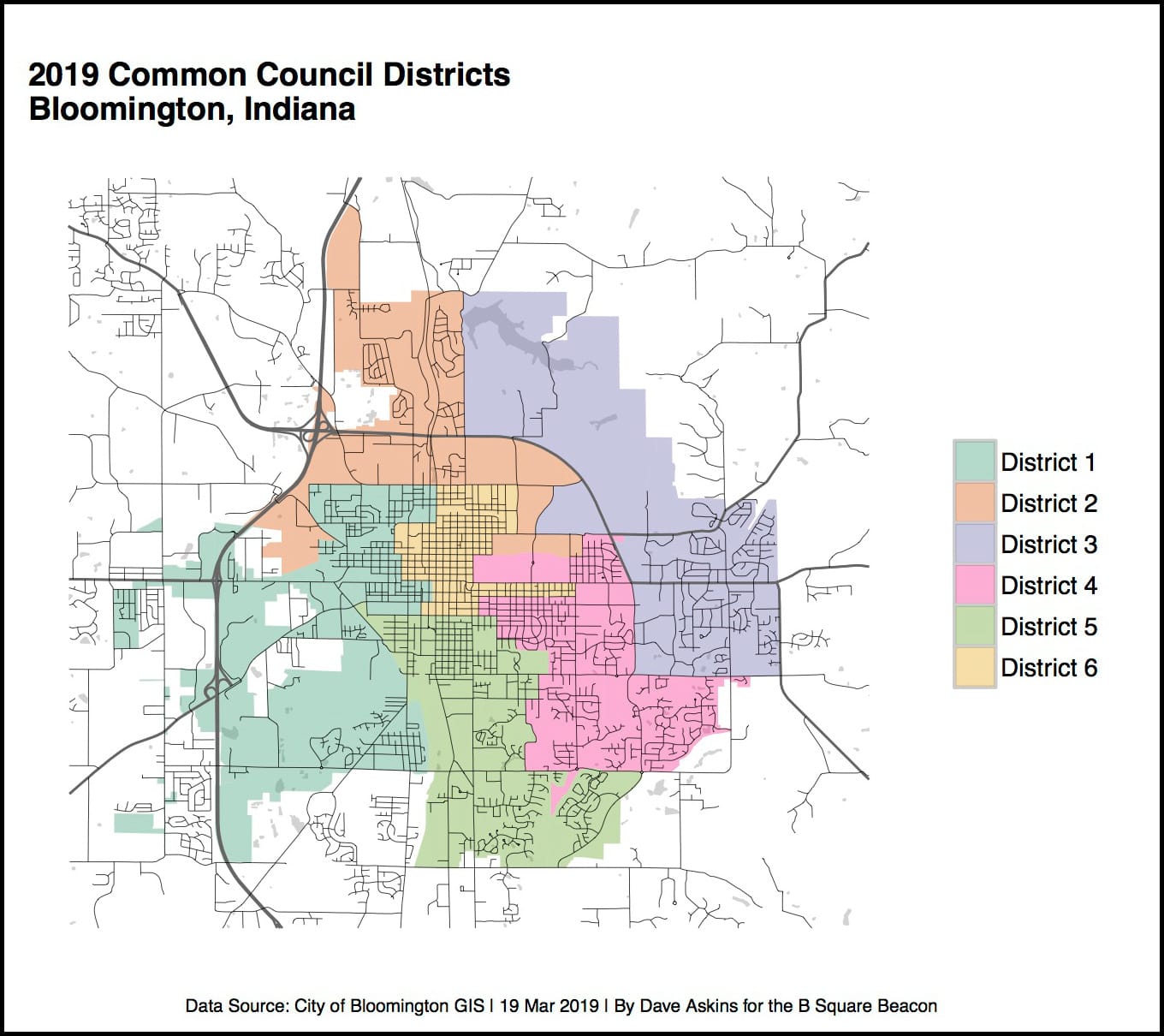Analysis: Bloomington’s new redistricting advisory commission



Last Wednesday (Dec. 16), at its last regular meeting of the year, Bloomington’s city council approved the creation of a new redistricting commission that will in 2022 be responsible for making recommendations on boundaries for the six city council districts.
The idea of creating such a commission was uncontroversial. It was approved on a unanimous vote by the nine-member city council, which is made up of nine Democrats.
The new citizens advisory redistricting commission will also have nine members, but just three will be Democrats. In addition to the “delegation” of three Democratic Party affiliates, the ordinance also calls for a three-member Republican Party delegation and a three-member delegation of members who aren’t affiliated with either of the two major parties.
Each of the three delegations on the new commission has to include a full-time Indiana University student.
Council president Steve Volan wrote the ordinance. The slogan he gave in support of the basic concept of a redistricting commission was: “We shouldn’t be choosing our voters; they should be choosing their representatives.”
Despite the slogan, the inclusion of the word “advisory” in the name of the new commission highlights the fact that it’s the city council that will make the decision on district boundaries. The ordinance just outlines a procedure by which the city council has to consider, and can reject the recommendation made by the commission.
The city council can’t legislate away its statutory responsibility to make the decision.
Under state law, the decision on the city council district boundaries does not take place until sometime during 2022, which is the “the second year after a year in which a federal decennial census is conducted.” This year was a census year.
The new ordinance establishes a commission for a two-year period that starts at least a year before the decision on district boundaries is made. That timing stems from the fact that the decision on boundaries for precincts—which can be considered the building blocks for city council districts—is made a year earlier by the county commissioners.
So sometime in 2021, Monroe County commissioners will sort through the precinct boundaries for the whole county, including the city of Bloomington. Under the ordinance adopted by the city council last week, Bloomington’s redistricting commission is also supposed to make recommendations about those precinct boundaries.
Last time around, in 2011, the county commissioners did not establish their boundary advisory committee until July 1. That means there’s still some time for the city council to gather applications for the new city redistricting commission and go through the selection process for members, which includes a random draw from a pool of candidates.
Issues raised during the council’s deliberations, by the public and councilmembers, included the council’s selection process for members of the commission, the diversity of the commission’s members, and issues related to studenthood of the commission’s membership.
Some of the issues were addressed through amendments to the ordinance.
Commission membership selection process
The ordinance establishing Bloomington’s redistricting advisory commission outlines how the nine members of the redistricting commission are to be chosen.
The process requires the creation of three separate pools of candidates, corresponding to the three “delegations” of Republicans, Democrats, and those not affiliated with either of those parties.
Each delegation’s pool has to contain six candidates, at least two of which have to be full-time IU students. From a pool of six, three members are chosen through a random process, which handles student and non-student members separately.
Commission membership selection process: Who selects the pools?
In the original draft of the ordinance, a group of three councilmembers consisting of the council’s president, vice president and parliamentarian were tasked with reviewing applications and determining the pools of six candidates.
Last time around, in 2012, the city council tasked a three-person committee of its own members to make a recommendation on district boundaries. The committee consisted of the three at-large councilmembers at the time: Susan Sandberg, Andy Ruff, and Timothy Mayer. Sandberg is the only one who remains on the city council.
At-large councilmembers are elected citywide. That means the boundaries of the six districts don’t affect their political future. Based on that fact, Sandberg suggested an amendment to change the group from the three council officers to the three at-large members.
The logic behind the choice of at-large members to handle the selection process made it an uncontroversial amendment for the council. It was adopted unanimously.
Commission membership selection process: Who draws the lots?
In the original draft of the legislation, it was the city clerk who was assigned the role of drawing lots or flipping a coin to pick members from the six-candidate pools. The city clerk is an elected official.
At last week’s council meeting, councilmember Kate Rosenbarger wanted to know why there was an amendment proposed which would strike the city clerk from the process. City clerk Nicole Bolden was eventually asked to comment. She said, “I reviewed the ordinance. I respect the redistricting commission. I think it’s a fine idea. But again, I decline to be a part of it or to place that role on future clerks. So, respectfully, no thank you.”
Instead of the city clerk, the task of the random draw was assigned through an ordinance amendment to the “ranking at-large” councilmember. Councilmembers were content that this year, at least, the longest serving councilmember is clear cut, even if it’s not guaranteed to be in the future.
Rosenbarger was the sole voice of dissent on the amendment removing the city clerk from the process.
This year, the longest-serving at-large member is Susan Sandberg, whose council service started in 2007. In 2018, Jim Sims was caucused in to replace Timothy Mayer, who resigned. Matt Flaherty’s service started this year on Jan. 1, after placing third in a 2019 vote-for-three primary race out of a pool that included Ruff.
Commission membership selection process: Is it fully determined?
The ordinance says about the makeup of the whole commission that “One member from each delegation…shall also be a duly enrolled full-time student at Indiana University Bloomington.”
A question posed by The Square Beacon during public comment time did not get a response during the meeting: Does that mean “exactly one member” or “at least one member”?
The answer has implications for how to apply the random drawing procedure from the pool of six candidates for each delegation.
The ordinance says: “At least two applicants from each pool shall be eligible to be student members.” If three applicants in the pool are eligible to be students, it’s not clear how to apply the selection process. It calls for a lottery to be conducted to select two non-students, and a coin-flip to decide “between the two student applicants from each pool.”
If the ordinance is interpreted to mean “exactly one” member from each delegation has to be a student, then faced with a six-person pool that includes three students, a natural way out of the dilemma would be to group the three students together and draw one from the three.
If the ordinance is interpreted to mean “at least one” member from each delegation has to be a student, then faced with a six-person pool that includes three students, one of the students could be thrown in with the non-students for the lottery—but which one?
For any one of the three students, they’d still have the same chance of being selected for the commission. The chance of being selected at random from a two-person group is the same as being among the two who are selected from a four-person group—it’s 50 percent either way. But the process would not be fully determined by the wording of the ordinance.
Responding to a followup question, city council attorney Stephen Lucas wrote in an email to The Square Beacon, “I think the intent of the sponsor was to ensure that each delegation included at least one student…”
Lucas added, “I think the reference to non-students in [the description of the selection process] could have been clarified.”
Lucas also said, “Given that the selection committee will be choosing the applicants that go into each pool of six, they’ll have some control over the make-up of the applicant pools, but they should certainly think through the scenarios you’ve suggested and, if necessary, seek clarification, perhaps through an amendatory ordinance.”
Membership criteria
The ordinance establishing the redistricting commission includes a number of qualifying and disqualifying criteria. Key among the qualifying criteria are affiliation with either the Democratic Party, Republican Party, or else non-affiliation with either of those parties.
Another other key qualifying criterion is full-time student status at Indiana University.
Disqualifying criteria include status as a current elected official or having been an elected official in the last 10 years. Also excluded is “anyone who has been an employee for an elected official.”
Any “immediate family member” of an excluded person is also ineligible to serve on the city’s redistricting commission.
Membership criteria: Diversity
During public comment time a question was posted about the random selection process: “Could you end up with all white men?”
The short answer is yes, but that possibility can be influenced by the composition of the pool of candidates.
Volan put it this way: “You can’t ensure anything, but I guess you can ensure it, by making sure that the vast majority of them are not white males. I don’t think that’s a bad idea.” Addressing the at-large city councilmembers, Volan added, “But unfortunately, for the three of you, you’re stuck with that obligation to try to pick enough people that that’s not a possibility.”
The ordinance itself does not include an explicit statement about diversity in the candidate pools.
That’s one way Bloomington’s ordinance differs from a League of Women Voters proposal for a state level legislative redistricting commission. The LWV proposal says, “The pool…should reasonably reflect the racial, ethnic, gender, age, and geographic diversity of the [city].”
The sentence about diversity is not included in Bloomington’s ordinance.
The intended connection between the LWV proposal and Bloomington’s ordinance can be found in a “whereas” clause in the ordinance. The clause indicates it is meant to provide a model for the state legislature to follow, by saying the city commission has a chance “to model a system in which the process of redistricting is done in an open manner…and wishes to persuade the State of Indiana to do likewise…”
The ordinance can be analyzed as an attempt to rise to the challenge made by Republican state representative Jeff Ellington at an early 2020 League of Women Voters (LWV) event that was held in Bloomington’s city council chambers.
At the event, responding to advocates for reform of the redistricting process for the state’s General Assembly districts, Ellington said, “Show us on the local level.” Ellington’s District 62 includes a southwestern chunk of Monroe County.
Membership criteria: Studenthood
During council deliberations, a question arose about why Indiana University students were the only students who qualify as student members of the commission.
Why not Ivy Tech students? Is it because Ivy Tech is located outside Bloomington city limits?
Volan said that his reasoning did not have anything to do with Ivy Tech’s location outside of the city limits. Instead, Volan said, it’s related to the fact that “Ivy Tech is not a residential college. It’s a college where people do not relocate, for the most part, to attend school there.”
Volan added that Ivy Tech students have a mix of ages. “They’re already represented among, let’s call it ‘the political class,’ but IU students are not,” Volan said.
Membership criteria: Party affiliation, voting record
The ordinance requires applicants to the commission to “attest that they are eligible to serve per the conditions…” Among the conditions to which the wording refers is one that says the commission has to be evenly divided into delegations of three: Republicans, Democrats and those not affiliated with either party.
The apparent intent is for applicants to attest to their party affiliation or non-affiliation. The ordinance does not make explicit how that would be verified.
Under a state statute on partisan-balanced boards and commissions, party affiliation is based on the most recent party primary in which a member voted. That statute is at the heart of current litigation in front of the court of appeals involving a Bloomington plan commission seat.
During public commentary, the even split among the major parties for the commission’s delegations was questioned, given that Bloomington voters have a clear lean towards Democratic Party candidates.
Participation in general elections is also part of the mix in the membership criteria for the redistricting commission. Each member has to have “voted as a resident of the city of Bloomington in at least one of the last two general elections immediately preceding their application.”
In the original draft of the ordinance, that was the requirement only for student members. In the original draft, other members had to have a longer voting record in general elections.
An amendment proposed by councilmember Sue Sgambelluri, to square up the voting history requirements for non-students and students, was unanimously approved by the city council.
Membership criteria: Employment
Excluded by the ordinance from eligibility on the city’s redistricting commission is “an employee for an elected official” within 10 years of the commission’s creation.
That’s different from a corresponding exclusion in the LWV proposal, which says “a staff member for a public official” is not eligible.
Asked by councilmember Sue Sgambelluri if he intended to extend the exclusion to employees of a company owned by a councilmember, Volan responded, “Exactly.”
Open process
Part of the intent of establishing a commission is to make the process of redistricting accessible to the public.
Open process: Activities at meetings
The ordinance explicitly states that the commission itself is subject to Indiana’s Open Door Law (ODL) and Access to Public Records Act (APRA).
Even absent that statement in the ordinance, the commission would still be subject to those laws. That’s because the entities subject to Indiana’s open government laws include: “any advisory commission, committee, or body created by statute, ordinance, or executive order to advise the governing body of a public agency…”
So the council’s selection committee consisting of at-large councilmembers would be subject to the ODL and the APRA, even though the ordinance does not explicitly state it.
The ordinance says that the selection committee “shall review all applications and in a public meeting choose 18 applicants in three pools of six…”
The activity of conducting the lottery, assigned to just one member of the selection committee, is not described explicitly by the ordinance as taking place at a public meeting. Would the ODL require the lottery to be conducted at a public meeting, when it’s an activity for just one councilmember?
Susan Sandberg, to whom the task of drawing the lots will fall, as longest serving councilmember, addressed the issue this way, “I would give assurance that this [drawing of lots] would be done in a public meeting. It would done according to protocol, and it would be done completely randomly.”
Open process: What does “bimonthly” mean?
The original draft of the ordinance included a requirement design to ensure a minimum frequency of meetings by the redistricting commission. The requirement said the commission had to hold public hearings “at least bimonthly, in January, March, May, July, September and November, but may choose to meet more often.”
In the course of a council discussion an amendment, brought forward by Isabel Piedmont-Smith, the meaning of the word “bimonthly” got some scrutiny.
Reacting to the sentiment that bimonthly is ambiguous between “twice a month” and “once every two months,” Volan claimed, “The word bimonthly means every two months. The phrase for twice-a-month is semi-monthly. It’s in the dictionary. ‘Bimonthly’ does not mean twice a month.”
As a public commenter conveyed through the Zoom chat feature: “Actually both meanings of bimonthly are in many dictionaries. Why not clarify?”
With dissent from Volan, the council settled on an amendment that read: “The Commission shall hold public hearings at least every other month, but may choose to meet more often.”




Comments ()